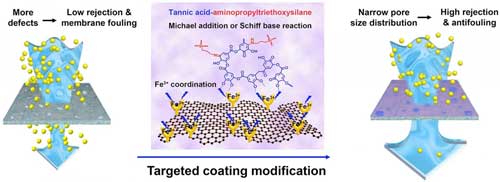| Jan 22, 2021 |
Targeted coating improves graphene oxide membranes for nanofiltration
(Nanowerk News) Nanofiltration (NF) is an advanced technology for treating wastewater containing organic micropollutants (OMPs).
|
|
Recently, a research group led by Prof. WAN Yinhua from the Institute of Process Engineering (IPE) of the Chinese Academy of Sciences developed a stable graphene oxide nanofiltration membrane with uniform pore size to remove OMPs.
|
|
The study was published in Chemical Engineering Journal ("Ferric ions mediated defects narrowing of graphene oxide nanofiltration membrane for robust removal of organic micropollutants").
|
|
It proposes combining signal amplification strategy and defect chemistry to reduce membrane pore size distribution, thus offering a promising method for preparing highly selective NF membranes.
|
 |
| Diagram of targeted coating modification on GO membrane. (Image: LI Sushuang) (click on image to enlarge)
|
|
Graphene oxide (GO) shows great potential in molecular sieving for use in NF. GO membranes are generally prepared by stacking GO nanosheets on a porous support layer. However, the use of GO membranes is limited due to their low stability in aqueous environments.
|
|
In addition, large defects resulting from non-uniform deposition of GO nanosheets can cause membranes to have low retention capacity and can also cause serious membrane fouling.
|
|
In their study, the researchers proposed a targeted modification strategy to simultaneously enhance the antifouling capacity of GO membranes and regulate their nanochannels.
|
|
Ferric ions (Fe3+) are first added to the GO solution to prepare a stable GO membrane (GO-Fe). "The added Fe3+ can amplify the signal of the defects on the GO-Fe membrane where larger transverse defects form due to the repulsive interaction between the adjacent GO nanosheets," said Prof. LUO Jianquan from IPE.
|
|
The GO-Fe membrane surface is subsequently modified by a targeted coating layer consisting of tannic acid-aminopropyltriethoxysilane (TA-APTES), and the larger membrane defects with more Fe3+ are then patched by the thicker TA-APTES coating. Such a "speckled" TA-APTES coating can simultaneously improve the antifouling capacity and narrow the pore size distribution of the Fe3+-mediated GO membrane.
|
|
"Compared to the commercially available polyamide NF membranes, our GO membrane with targeted coating shows higher and more stable rejections on various OMPs, even in long-term operation, cross-flow filtration or under high pressure," said Prof. LUO.
|

